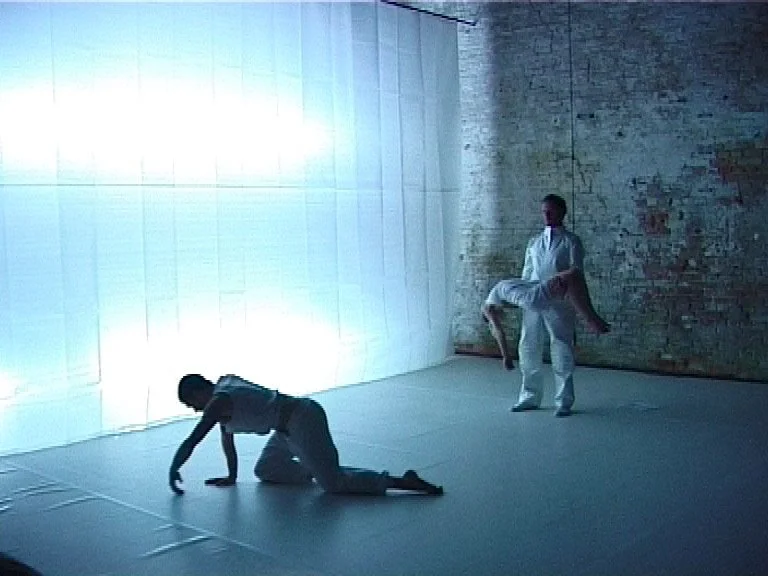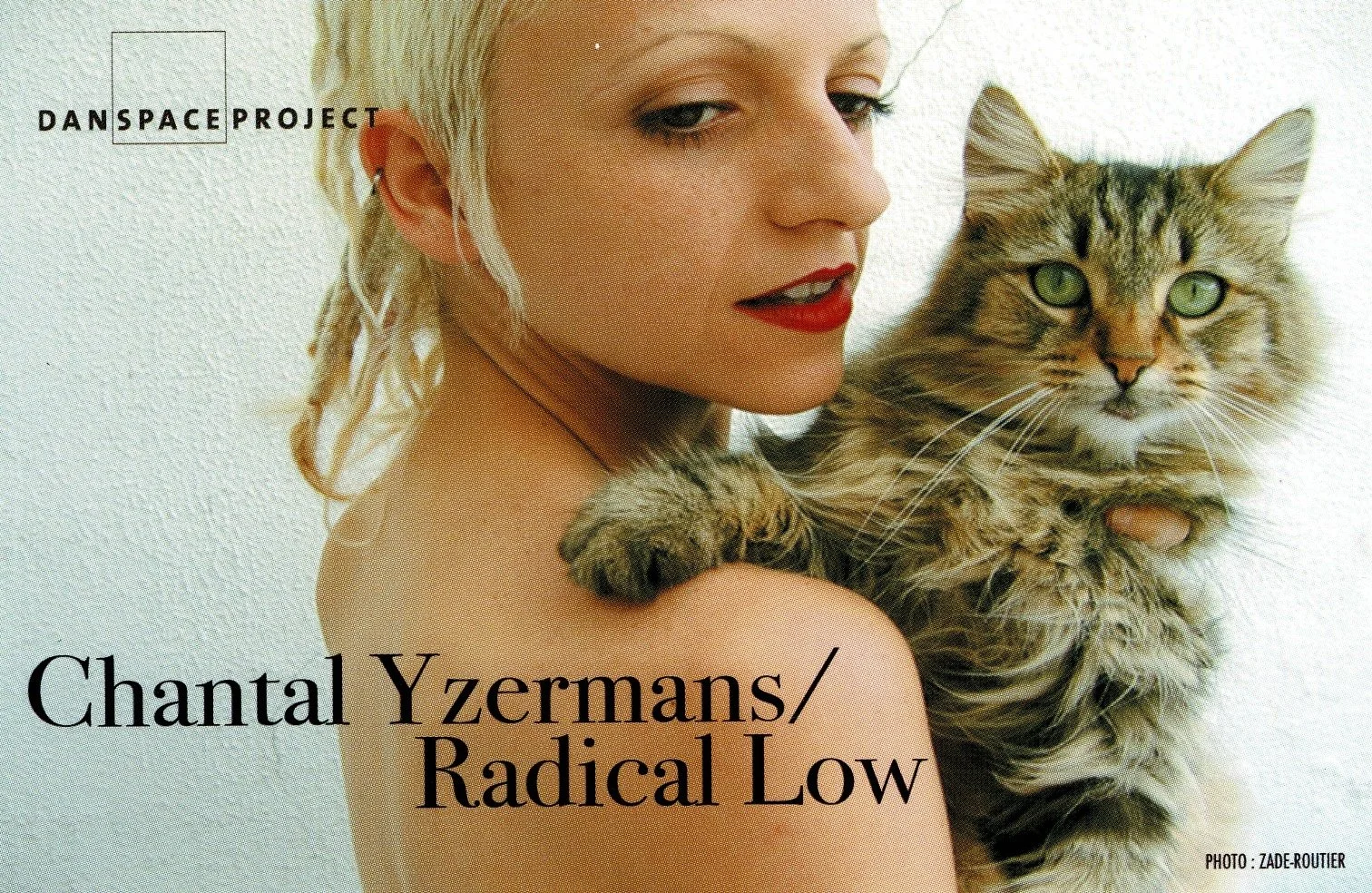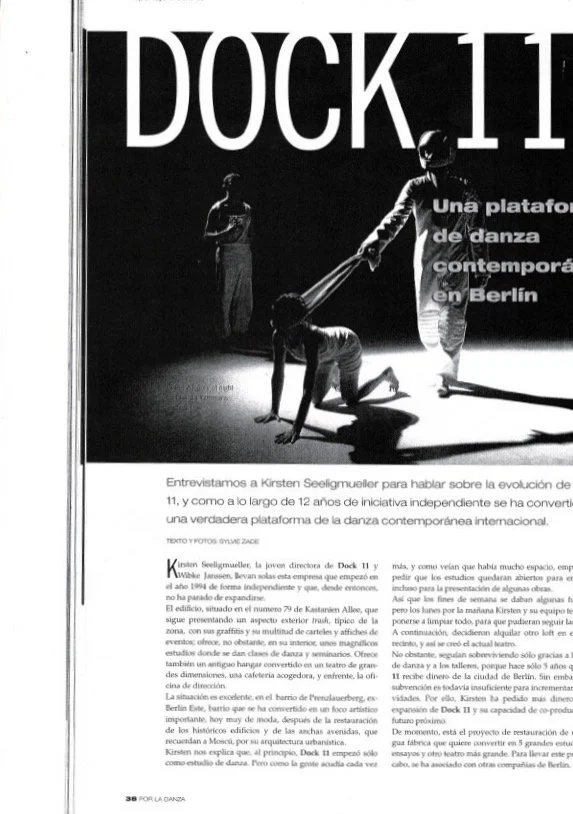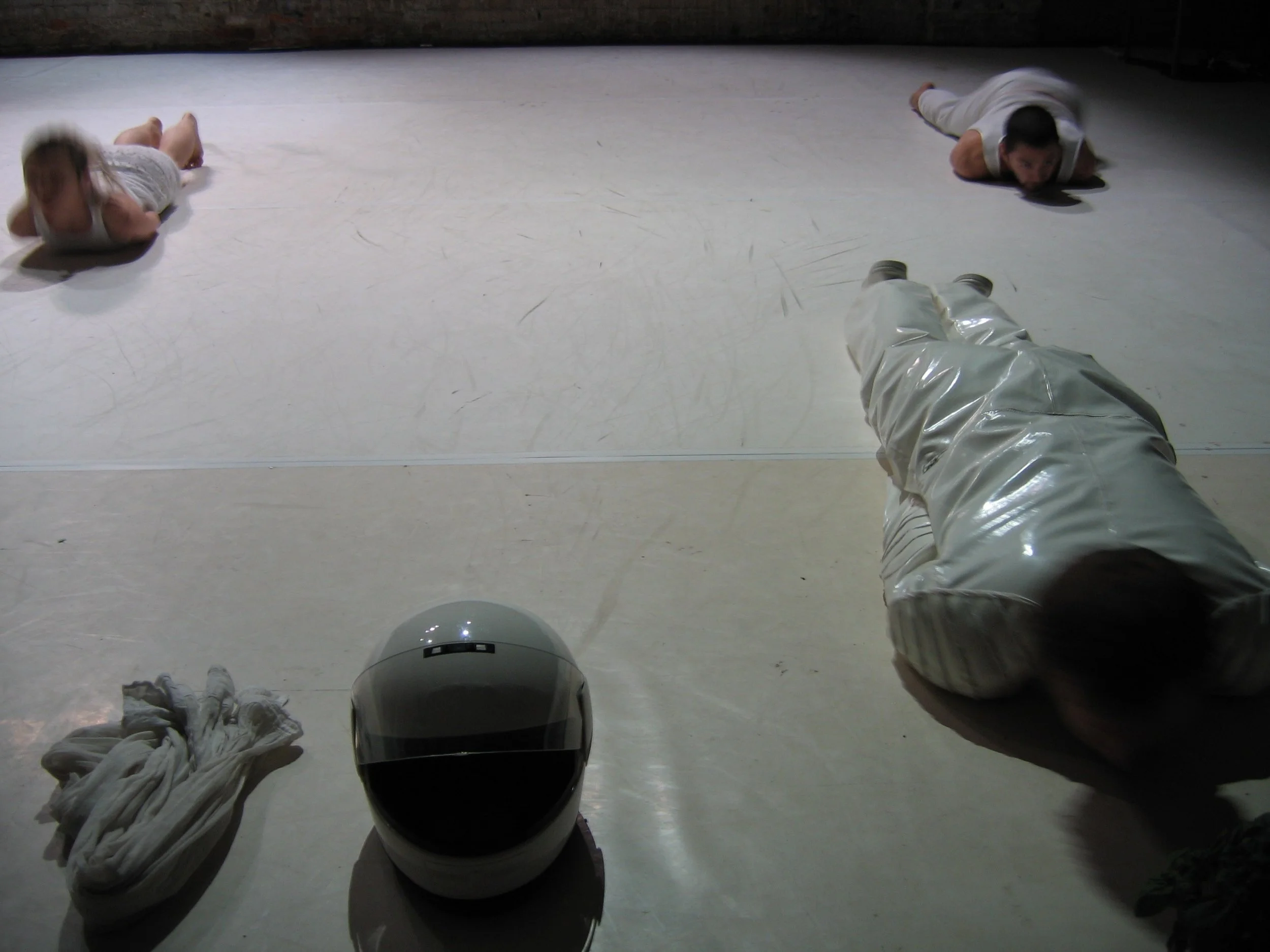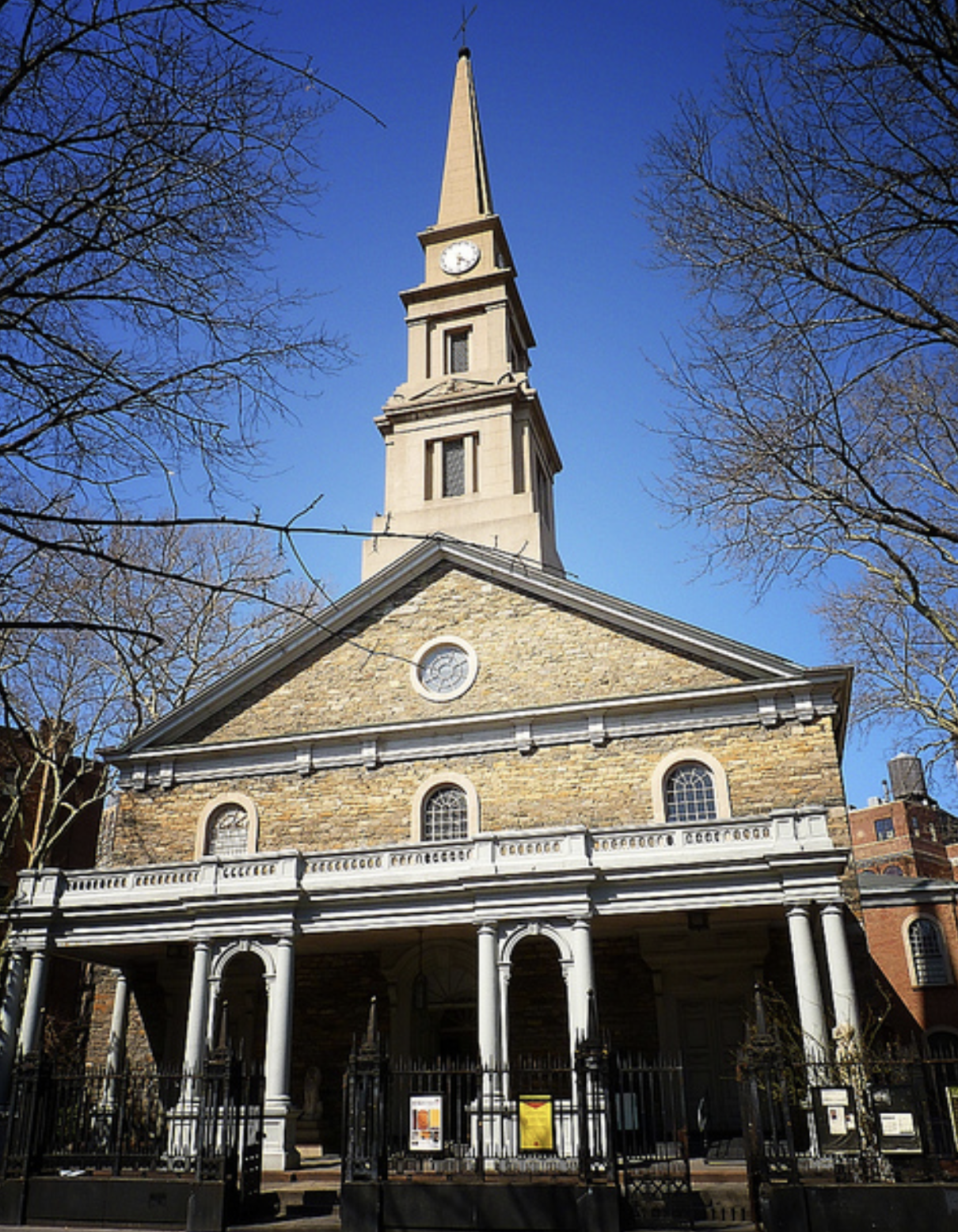Your Custom Text Here
PRESS 2007
Onri, Allegory of Night
Images by Sylvia Zade Routier for the performance at Dancespace Project New York City , March 2007
performers : Ashley Chen, Litsa Kioutsi, Marco Wittorf & Cheryl Therrien
The night for me meant waiting till dawn.
Choreographer and dancer Chantal Yzermans in conversation with Marie De Corte
Chantal Yzermans is opening this year’s season at ccBe with “ONR-I, allegory of night”. Chantal has returned recently from New York, where she has lived for 5 years, and collaborated with video-artists in pure improvisation around the artificial of video as opposed to the living material of the moving body. I’m really curious to find out about the next step in her artistic path after having worked for a month in Buda arts centre in Kortrijk.
How did these five years in New York affect you? What do they mean for your artistic path? Did you miss anything at all from Belgium?
Chantal Yzermans: Over there, I missed nothing from Belgium. New York is the city of granite, the eternal movement and illusion. Life is very flashy and direct. There’s no time to analyse. Everything is instant.
I went to New York to study with Merce Cunningham. I had received a Full Merit scholarship with the Merce Cunningham Company, which means that I had the opportunity for five years, to receive an intensive training from Merce Cunningham himself, together with the dancers of the company, in technique and repertoire.
Apart from that, there were the artistic encounters: with butoh-dancer Kota Yamazaki: dance improvisations as a performance in and around New York, having lived with and modelled for painter (as a model) and filmmaker David Young, having worked with jazz-musician Michael Attias as an improvisation duo.
I received artistic residencies at the Movement Research & Harkness Dance Center in New York City, where I worked with musician Hrvatski and video maker Kurt Ralske.
What was the spark that set off ONR-I, allegory of night?
When I was in New York, I was fascinated by the black scene, and in particular by the strong physicality of black dancers. They still have this brute animal power and this big urge to move. At the same time it is as if the sacred is still present in their movements. The initial idea for ONR-I – an anagram for NOIR – was to create a poem in space with five black dancers. This idea later evolved to the negative of this idea. The cast now consists of two dancers, one from New York, one from Athens, and one actor from Berlin.
What do you want to investigate during this performance, and what are your sources?
The mixture of all art forms – especially in the performing arts – makes the theatre today a laboratory. The image dance-theatre-music is being analysed, commented on, and used in a new way.
With this project I want to focus on the language of the movement, driven by the theme “obscurity”.
During the working process, we have separated the audio material (text and sounds cape) of Sunset Boulevard from the visual images and we focused on the sounds cape. We are putting together new artificial images with a minimal narrative from this movie. Parallel to this we are looking for the power of expression of the movement without any interaction with the technology of video.
How is the creation process going?
Through improvisation we select movement phrases that we sculpt through different parameters such as musicality, space, intensity and colour, in order to, eventually change the movement through the incidence of light like in the work of Caravaggio.
His work inspires me. Caravaggio’s visible world goes beyond the presentation of the objects and characters of the play of lines and colour. The incidence of light in his work awakens the subject. The volume lives, is blown up, sometimes up to the point of becoming monstrous. Everything that is deprived from light seems dissolve. These two worlds compete in an attractive, dynamic way, and it’s exactly this that is transmitted in my work today.
In origin, I’m an abstract dancer. With this creation I evolve to the theatrical through the need of different layers of meaning; via movement to literature, poetry and film. The raw force of the original movement material then is being distilled and aestheticised.
Is there a connection between the work and a memory from your youth?
As a child I slept really bad. The night for me meant waiting until dawn.
Why have you chosen to collaborate with sculpting artist Martine Schildge?
In her work I recognised an artistic sensitivity and, in her latest installation I was captivated by the antagonism of the visceral content and the fragility of the outside, little cotton houses.
Do you believe that an artist has to play a political role in his work? What does it mean for you to be an artist?
An artist who is propagating in his work a political message on ethical or moral grounds, will disappoint himself. He damages his work and his environment. My motive is the aesthetic thrill, the fascination of the intangible, observing beauty and constantly questioning myself. Producing art for me is a way of transcending the mediocrity and greyness of society, of the masses.
Were you born in an arts nest? Which encounters have been important for you as an artist? Which artist do you find inspiring?
My parents were hardworking tradespeople. My father was a hairdresser. In my education no artistic stimulus was present at all.
Apart from my encounter with Merce Cunningham, my most beautiful friendship was the one with George Liker (75). He was a dancer in the original cast of West Side Story in Broadway in ’57. He’s a remarkable personality and he is a real New Yorker.
I like artists that aestheticise the concept of their work. Video artist Bill Viola and Bruce Nauman (also know for his neon art) and the choreographer Merce Cunningham.
What’s your position on subsidies?
I think of myself as an independent artist with a big necessity to make things. What is see now is that many of the accomplished names just keep on making productions without feeling that necessity. They are repeating themselves. The arts world has become a consumption world. What I want to do is simply to go on working without being dragged along with this circus. I still admire Merce Cunningham because he has remained honest in his artistic search.
How do you see the future?
Today I am reading “Later Auden” by Edward Mendelson, a biography of Auden’s life and work. Tomorrow I’ll continue reading because it’s a thick book. That is my future.
Do you think of the performance in ccBe as an opening night?
No. It’s a first official getting acquainted with the Belgian audience. The creation will evolve by performing it. In December we’re going to Berlin. And next year New York, Madrid and Valencia …
To whom or what would you like to dedicate this performance?
To the 50.000 dogs that are being slaughtered in China because a dozen of people died from a virus they caught from a dog.
As a dancer, Marie De Corte worked with a.o. Alain Platel and Marc Vanrunxt. As of 1986 she is choreographing for her own company AIR de C, and as a guest choreographer for a.o. Blauw Vier, Bronks and Pascale Platel. Last year she created “Apekool met frietjes”, together with Sandra Delgadillo
mariedecorte@skynet.be
DANCE INSIDER 2008
By Chantal Yzermans
27.03.2008
http://www.danceinsider.com/
(Editors note : We asked the author, who now creates in Antwerp and Berlin after seven years in New York, where her season runs tonight through Saturday at Danscpace Project at St.Mark’s Church, to comment on the influence of space on her work)
To travel from place to place and fin fresh green pasture to survive and continue the artistic research : this is the characteristic related to my lifestyle. Although I started my education as a dancer in Belgium, the great turn for me was coming to New York with its dance community pulsating like nowhere else; mainly , the city itself, opening a wider scope, to a different and enriching vision of the world, like food for the senses.
NY urban life transmitted a whole new freedom to my mind. Whether on a full-merit scholarship at the Merce Cunningham Studio, or artist in residence at Movement Research ( 2002) it enriched that creative impulse in me.
Having nourished myself from the vast variety of the urban faune life in NYC, during all those years, my coming back to Europe in 2006 was obviously transformed.
In Antwerp, in fact, I continue to be in touch with all the people I knew and worked with in NY, like Cheryl Therrien, Ashley Chen or Litsa Kioutsi from Athens. As a base, my house in Antwerpen is large enough to be able to invite dancers and other artistic collaborators from different nationalities to stay. The New Yorkers, being exceptionally good and committed to a unique faith and dedication for art, live on the contrary like ants in large swarms. Studios to rehearse are much cheaper in Europe , too.
Radical Low, the collaborative in which we work, has its official seat now in Antwerpen.
It is a very young collective applying for arts grants in Belgium and in other countries .These financial supports are currently not generous enough and take such a long time to get, but they do help to move on.
‘Onri, Allegory of Night’ has also been supported by funds from Dancespace Project Commissioning Initiative 2006.Currently , I travel in between Germany and Belgium, since I work with two performers living in Berlin , Marco Wittorf and Litsa Kioutsi.
‘Onri,Allegory of Night’ started as a work in progress in Berlin at Dock 11, with the French actress Stephanie Lupo and Sylvia Zade Routier the videographer.An artistic residency at Buda Arts Center in Belgium made this work grow into a longer, more intense work.The original cast has evolved since its initial spark in Berlin.
In NY at Danspace Project it is presented with live music by Belgian composer Koen Lybaert.The theatrical design has evolved with the collaboration of French visual artist Martine Schildge.
Travelling to different countries and working in different spaces had, and has every time, an impact on my work. To practice and design performances in different environments, different cities like here at Danspace Project ,specifically in the church of St Marks’, places the physical features of ‘Onri, Allegory of Night’ into a new situation and artistic challenge. It becomes part of the anatomical life of Radical Low and its collaborations.But the core is the artists itself, who creates and build up the heart of the work.
Whichever city or conditions we are in, the goal remains the capacity of growing into my own work as an independent artist.
Onri, Allegory of Night at Dock 11, a platform for contemporary dance in Berlin December 2007 a reportage by Sylvia Zade Routier
performers : Ashley Chen, Litsa Kioutsi, Marco Wittorf & Cheryl Therrien
costumes : Maartje Van Bourgognie
live music : Koen Lybaert
St.Markschurch / DancespaceProject in New York City
“Underworld, and they are dancing in the dark’”
March , 2007. Chantal Yzermans, the Belgian director of the group Radical Low, began her new work, “ONR-I, allegory of night,” at the Danspace Project on Friday with the sort of alluring preshow that makes the rest suffer. Topless and wearing sunglasses and white cropped hipster pants embellished with clear plastic on her torso and calves, Ms. Yzermans traversed the stage, rising on her toes until her wobbly hip rocked off balance. Joining her was Ashley Chen, a smoldering dancer whose arching backbends and wild, whipping legs lent an odd symmetry to Ms. Yzermans’s unhurried, finite details.
The work, set in a dark underworld in which the stories of Orpheus and Hephaestus intertwined ambiguously, included live electronic music by the Belgian electronic composer Koen Lybaert (a k a Ontayso) and an unremarkable set, featuring a white scrim and a swirling sculpture of white fabric. Visual art was credited to Martine Schildge.
In a particularly meandering program note, Ms. Yzermans stated: “Time rules. And for the sleepless night, means waiting ’til dawn.” For “ONR-I,” an anagram for noir, it would be more apt to say that time crept. After describing how her initial impulse for “ONR-I” was to create a piece for black dancers — apparently the resulting work was a “negative of this idea” — Ms. Yzermans departed the stage, leaving Mr. Chen, Litsa Kiousi, Cheryl Therrien and Marco Wittorf grappling in search of light.
The choreography itself — waving arms and off-kilter balances — generated little in the way of movement vocabulary, and Mr. Wittorf, encased in a white vinyl jumpsuit by Maartje van Bourgognie, was prone to opaque speeches that alluded to the Greek god Hephaestus. At the same time, the plight among the other dancers was frequently vague.
If “ONR-I” was visually all about atmosphere, there was little to grasp, either in the muted lighting by Carol Mullins or in the overall work, which seemed too entrenched in process to emerge as a fully realized whole. Strange how the night moves? Not strange enough.
